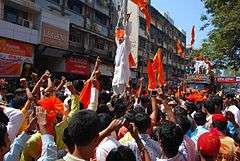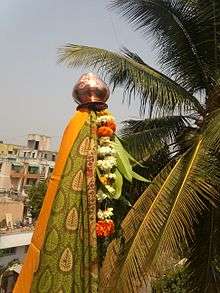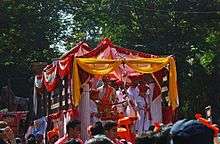Gudi Padwa
| Gudhi Padva (Guḍhī 1yy) | |
|---|---|
 A Gudhi Padwa new year festive procession in Maharashtra | |
| Official name | Gudhi Padva |
| Observed by | Mahasrashtra Hindus |
| Type | Hindu |
| Celebrations | 1 day |
| Begins | Chaitra Shuddha Padyami |
| Date | March / April |
| 2017 date | Tues, 28 March[1] |
| 2018 date | Sun, 18 March[2] |
| Frequency | annual |
| Related to | Ugadi and other Hindu new year festivals |
Gudhi Padva (Marathi, Konkani: गुढी पाडवा, IAST: Guḍhī Pāḍavā) is a spring-time festival that marks the traditional new year for Marathi Hindus.[3] It is celebrated in and near Maharashtra on the first day of the Chaitra month to mark the beginning of the New year according to the lunisolar Hindu calendar. The word पाडवा (pāḍavā) or पाडवो (pāḍavo) or पड्ड्वा/पाड्ड्वो (pāḍḍvā/pāḍḍvo) comes from the Sanskrit word प्रतिपद (pratipada) or प्रतिपदा (pratipadā) in Sanskrit, which refers to the first day of a lunar fortnight. The festival is observed with colorful floor decorations called rangoli, a special Gudhi flag (garlanded with flowers, mango and neem leaves, topped with upturned silver or copper vessel), street processions, dancing and festive foods.[3][4]
In south India, first day of the bright phase of the moon is called pāḍya (Konkani: पाडयो;Kannada: ಪಾಡ್ಯ; Telugu: పాడ్యమి, paadyami; ). Konkani Hindus variously refer to the day as सौसार पाडवो or सौसार पाडयो (saṁsāra pāḍavo / saṁsāra pāḍye), संसार (saṁsāra) being a corruption of the word संवत्सर (saṁvatsara). Telugu Hindus celebrate the same occasion as Ugadi, while Konkani and Kannada Hindus in Karnataka refer to it as युगादि, ಯುಗಾದಿ (yugādi). The same new year festival is known by other names in different regions of the Indian subcontinent. However, this is not the universal new year for all Hindus. For some, such as those in and near Gujarat, the new year festivities coincide with the five day Diwali festival.[5] For many others, the new year falls on Vaisakhi between April 13 to 15, according to the solar cycle part of the Hindu lunisolar calendar, and this is by far the most popular not only among Hindus of the Indian subcontinent but also among Buddhists and Hindus in many parts of southeast Asia.[5]
The Sindhi community celebrates this day as Cheti Chand as the new year and observed as the emergence day of Lord Jhulelaal. Prayers are offered to Lord Jhulelaal and the festival is celebrated by making delicacies like Tehri (sweet rice) and Saai Bhaaji (Palak made in dal).
Etymology

Gudhi means flag, erect flag on the houses as part of celebration in Maharashtra where its mainly celebrated.According to Kittel word belongs to South Indian language origin.[6]
The word pāḍavā is derived from the Sanskrit word pratipad for the first day of each fortnight in a lunar month i.e. the first day on which the moon appears after the so-called "new moon" day (amāvāsya) and the first day after the full moon. A Gudhi is also hoisted on this occasion giving this festival its name. The term padva or padavo is also associated with balipratipad the third day of Diwali which is another celebration that comes at the end of the harvesting season.
Significance
Gudhi Padva signifies the arrival of spring and to the reaping of Rabi crops.[7]
The festival is linked to the mythical day on which Hindu god Brahma created time and universe. To some, it commemorates the coronation of Rama in Ayodhya after his victory over evil Ravana, or alternatively the start of Shalivahan calendar after he defeated the Huns invasion in the 1st century.[8]
According to Anne Feldhaus, in rural Maharashtra the festival is linked to Shiva's dance and coming together of the community as they carry the Gudhi Kavads together to a Shiva temple.[9]
The Guḍhī
A notable sight during Gudhi Padwa are the numerous Gudhi (or Gudhi) arrangements at every household. It is a bright colorful silk scarf-like cloth tied at the top of a long bamboo. On top of it, one or more boughs of neem leaves and mango leaves are attached along with a garland of flowers. This arrangement is capped with a silver, bronze or copper pot (handi or kalash) signifying victory or achievement.[10][11] The whole arrangement is hoisted outside each household, typically to the right, or through a window or terrace. It is visible to everybody. Villages or neighborhoods also come together and host a community Gudhi Kavad, which they carry together to the local Shiva temple. Some temples are located on the top of hills, and groups work together to help reach the kavad to the top.[11]
Some of the significances attributed to raising a Gudhi are as follows:

- It symbolizes the victory of King Shalivahana and was hoisted by his people when he returned to Paithan.[7]
- Gudhi symbolizes the Brahmadhvaj (translation: Brahma’s flag) mentioned in the Brahma Purana, because Lord Brahma created the universe on this day. It may also represent Indradhvaj (translation: the flag of Indra).[7]
- Historically, the Gudhi symbolizes Lord Rama’s victory and happiness on returning to Ayodhya after slaying Ravana. Since a symbol of victory is always held high, so is the gudhi (flag). It is believed that this festival is celebrated to commemorate the coronation of Rama post his return to Ayodhya after completing 14 years of exile.[7] So, people celebrated victory of lord Rama every year by raising Gudhi. Gudhi is symbol of victory of lord Rama
- Gudhi is believed to ward off evil, invite prosperity and good luck into the house.[7]
Festivities

On the festive day, courtyards in village houses will be swept clean and plastered with fresh cow-dung. Even in the city, people take the time out to do some spring cleaning. Women and children work on intricate rangoli designs on their doorsteps, the vibrant colours mirroring the burst of colour associated with spring. Everyone dresses up in new clothes and it is a time for family gatherings.
Traditionally, families prepare a special dish that mixes various flavors, particularly the bitter leaves of the neem tree and sweet jaggery (gur, gul). Additional ingredients include sour tamarind and astringent dhane seeds. This, like the pacchadi recipe used in Ugadi festival, is eaten as a reminder of life's sweet and bitter experiences, as well as a belief that the neem-based mixture has health benefits.[10][12]
Maharashtrian families also make many other festive dishes, such as shrikhand and Poori or Puran Poli on this day.
Guḍhī Pāḍavā in other languages, states and people
Known as Guḍhī Pāḍavā ("Gudhee Paadavaa") in Maharashtra, this festival is also known as[13]
- Samvatsar Padvo among Hindu Konkanis of Goa and Konkani diaspora in Kerala[14]
- Yugadi among the rest of Konkani diaspora in Karnataka and Ugadi in Andhra pradesh Telangana State and Navreh or Navreh amongst Kashmiri Pandits
In other parts of India[13] this festival is celebrated during
- Ugadi in Andhra Pradesh and Telangana State
- Yugadi in Karnataka
- Cheti Chand among the Sindhi people
It is also celebrated in the North-East state of Manipur as Sajibu Nongma Panba Cheiraoba and also in countries like Nepal, Burma, Cambodia and other nations where there are lot of Hindus. People prepare a variety of food and cuisine on this day and later climb the hillocks in the evening.
In Kashmir as Nau roz, In Punjab as Baisakhi, in Bengal as Naba Barsha, in Assam as Bihu, in Kerala as Vishu, in Tamil Nadu as Putuhandu . It is considered as most auspicious day of the year.
See also
References
- ↑ 2017 Official Holiday Calendar, Government of Maharashtra, page amj3-4
- ↑ 2018 Gudi Padwa
- 1 2 Roshen Dalal (2010). Hinduism: An Alphabetical Guide. Penguin Books. p. 150. ISBN 978-0-14-341421-6.
- ↑ Gudi Padwa, Government of Maharashtra (2016)
- 1 2 Karen Pechilis; Selva J. Raj (2013). South Asian Religions: Tradition and Today. Routledge. pp. 48–49. ISBN 978-0-415-44851-2.
- ↑ Gowda, Deve; Gowda, Javare. Village Names of Mysore District: An Analytical Study. p. 55. ISBN 81-206-1390-2. Retrieved 17 March 2018.
- 1 2 3 4 5 "Significance of Gudhi Padwa". Hindu Jagriti Samiti. Archived from the original on 2013-04-14.
- ↑ Gudi Padva, Government of Maharashtra Tourism Office
- ↑ Anne Feldhaus (2003). Connected Places: Region, Pilgrimage, and Geographical Imagination in India. Palgrave Macmillan. pp. 48–57, 72–83. ISBN 978-1-4039-8134-9.
- 1 2 William D. Crump (2014). Encyclopedia of New Year's Holidays Worldwide. McFarland. p. 114. ISBN 978-0-7864-9545-0.
- 1 2 Anne Feldhaus (2003). Connected Places: Region, Pilgrimage, and Geographical Imagination in India. Palgrave Macmillan. pp. 48–57. ISBN 978-1-4039-8134-9.
- ↑ Ernest Small (2011). Top 100 Exotic Food Plants. CRC Press. p. 411. ISBN 978-1-4398-5688-8.
- 1 2 "Chaitra Shukla Pratipada (Gudhi Padwa)". Hindu Janajagruti Samiti.
- ↑ Gajrani, S. History, Religion and Culture of India. Volume 3. p. 108.

